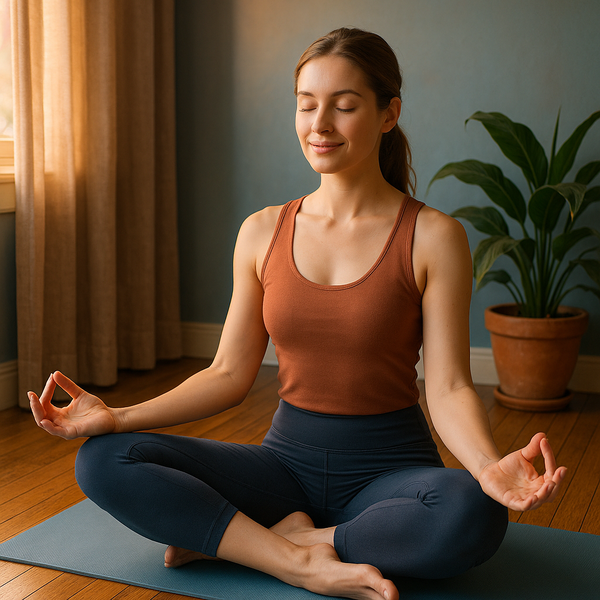
Embarking on a yoga journey can be incredibly rewarding for both your body and mind. As a beginner, the world of yoga might seem vast, but with a few fundamental poses and a focus on mindful movement, you can build a strong foundation. This guide is designed to ease you into the practice, offering simple poses and explaining the amazing benefits awaiting you on the mat.
Getting Started with Essential Yoga Poses
For those new to yoga, starting with foundational poses is key to developing proper alignment and building strength. The Mountain Pose (Tadasana) is your starting point, grounding you and teaching you to stand tall with an engaged core. From here, you can explore the gentle stretch of the Downward-Facing Dog (Adho Mukha Svanasana), which is fantastic for lengthening the spine and strengthening the arms and legs. Another crucial pose is the Child's Pose (Balasana), a resting posture that allows for deep relaxation and a gentle release in the back. The Cobra Pose (Bhujangasana) offers a mild backbend, promoting spinal flexibility and opening the chest, while the Seated Forward Bend (Paschimottanasana) provides a hamstring stretch and calms the nervous system. Remember to breathe deeply and move with intention, listening to your body and avoiding any strain. Consistency is more important than intensity when you're beginning, so aim for regular, short sessions to build your confidence and familiarity with these basic movements.
The Holistic Benefits of a Regular Yoga Practice
Yoga offers a comprehensive approach to well-being, impacting physical, mental, and even emotional health. Physically, regular practice improves flexibility, strength, and balance. Poses are designed to stretch and strengthen muscles, improve joint mobility, and enhance your overall posture. This can lead to reduced aches and pains, particularly in the back and neck. Furthermore, yoga can boost circulation, improve respiration, and support a healthy cardiovascular system. Beyond the physical, yoga is a powerful tool for mental clarity and stress reduction. The focus on breath control (pranayama) and mindful movement helps to quiet a busy mind, fostering a sense of calm and presence. This can lead to better sleep, increased concentration, and a more positive outlook on life. By integrating yoga into your routine, you are investing in a healthier, more balanced you, both inside and out, creating a positive feedback loop that enhances your daily life.
Creating Your Beginner-Friendly Yoga Routine
To establish a successful beginner yoga routine, focus on simplicity and consistency. Begin by dedicating 15-20 minutes a few times a week. Choose a quiet, comfortable space where you won't be disturbed. Lay down a yoga mat for cushioning and support. Start your practice with a few moments of seated meditation or deep breathing to center yourself. Then, move through a sequence of gentle poses, such as those mentioned earlier, holding each for 3-5 breaths. Consider incorporating Sun Salutations A (Surya Namaskar A) as you gain more confidence, as they offer a flowing sequence to warm up the body. It’s also beneficial to include restorative poses like Savasana (Corpse Pose) at the end of your practice to allow your body and mind to fully relax and integrate the benefits. Listen to your body; if a pose feels uncomfortable or causes pain, modify it or skip it. Gradually increase the duration and frequency of your sessions as you feel stronger and more comfortable, exploring new poses and sequences as your journey progresses.
Understanding Breathwork and Mindfulness in Yoga
Breathwork, or pranayama, is a cornerstone of yoga, intricately linked with movement and mindfulness. The way you breathe significantly influences your energy levels and mental state. For beginners, focusing on diaphragmatic breathing, also known as belly breathing, is an excellent starting point. Inhale deeply through your nose, allowing your belly to expand, and exhale slowly through your nose or mouth. This type of breathing is calming and helps to activate the parasympathetic nervous system, promoting relaxation. Mindfulness in yoga involves paying attention to your body's sensations, your breath, and your thoughts without judgment. During poses, notice how your body feels, where you feel stretches, and any tension you might be holding. By cultivating this awareness, you deepen your connection to yourself and enhance the therapeutic effects of your practice. This mindful approach extends beyond the mat, helping you to become more present and engaged in your everyday life, reducing stress and increasing overall well-being.
The Long-Term Advantages of Embracing Yoga
Committing to a yoga practice over the long term yields profound and lasting advantages. As you continue to explore different poses and sequences, your physical capabilities will expand significantly. Increased muscle tone, improved cardiovascular health, and a greater sense of bodily awareness become hallmarks of a dedicated yogi. Many practitioners report a noticeable reduction in chronic pain and a greater ease of movement in daily activities. Mentally, the benefits are equally compelling. Yoga's emphasis on present moment awareness and breath control can lead to a significant reduction in anxiety and symptoms of depression. Over time, you may find yourself better equipped to handle stress, experiencing a greater sense of emotional resilience and inner peace. This holistic improvement fosters a more balanced and fulfilling life, where physical vitality is matched by mental and emotional stability. The journey of yoga is one of continuous learning and growth, offering a lifelong path to improved health and well-being.